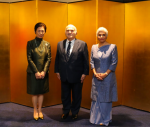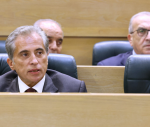You are here
Iraqi army controls main roads out of Mosul, trapping Daesh
By Reuters - Mar 01,2017 - Last updated at Mar 01,2017

Displaced Iraqis flee their homes in Mamoun district as Iraqi forces battle with Daesh militants, in western Mosul, Iraq, on Wednesday (Reuters photo)
MOSUL — US-backed Iraqi army units on Wednesday took control of the last major road out of western Mosul that had been in Daesh's hands, trapping the militants in a shrinking area within the city, a general and residents said.
The army's 9th Armoured Division was within a kilometre of Mosul's Syria Gate, the city's northwestern entrance, a general from the unit told Reuters by telephone.
"We effectively control the road, it is in our sight," he said.
Mosul residents said they had not been able to travel on the highway that starts at the Syria Gate since Tuesday. The road links Mosul to Tal Afar, another Daesh stronghold 60km to the west, and then to Syria.
Iraqi forces captured the eastern side of Mosul in January after 100 days of fighting and launched their attack on the districts that lie west of the Tigris River on
February 19.
If they defeat Daesh in Mosul, that would crush the Iraq wing of the “caliphate” declared by the group's leader Abu Bakr Al Baghdadi in 2014 from the city's grand old Nuri Mosque.
The US-led coalition effort against Daesh is killing the group’s fighters more quickly than it can replace them, British Major General Rupert Jones, deputy commander for the Combined Joint Task Force said.
With more than 45,000 killed by coalition air strikes up to August last year, “their destruction just becomes really a matter of time,” he said on Tuesday in London.
The US commander in Iraq, Lieutenant General Stephen Townsend, has said he believes US-backed forces will recapture both Mosul and Raqqa, Daesh’s Syria stronghold in neighbouring Syria, within six months.
The closing of the westward highway meant that Daesh are besieged in the city centre, said Lt. Gen. Abdul Wahab Al Saidi, the deputy commander of the Counter-Terrorism Service (CTS), deployed in the southwestern side.
Units from the elite US-trained division battled incoming sniper and anti-tank fire as they moved eastwards, through Wadi Al Hajar district, and northward, through Al Mansour and Al Shuhada districts where gunfire and explosions could be heard.
These moves would allow the CTS to link up with Rapid Response and Federal Police units deployed by the riverside, and to link up with the 9th Armoured Division coming from the west, tightening the noose around the militants.
“Many of them were killed, and for those who are still positioned in the residential neighbourhoods, they either pull back or get killed are our forces move forward,” Saidi said.
Two militants lay dead near the field command of the CTS, in the Al Mamoun district which looked like a ghost town. A few hundred metres away, a car bomb was hit by an air strike.
Strafing from above
The few families who remained in Al Mamoun said they were too scared to leave as the militants had booby-trapped cars.
Women cooked bread over outdoor ovens while men gathered on street corners as helicopters flew overhead strafing suspected militant positions further north.
One of two buses parked nearby had its roof shorn off. Residents buried a 60-year-old woman who was killed on Tuesday when she stepped on an explosive device while trying to flee.
Several thousand militants, including many who traveled from Western countries to join up, are believed to be in Mosul among a remaining civilian population estimated at the start of the offensive at 750,000.
They are using mortars, sniper fire, booby traps and suicide car bombs to fight the offensive carried out by a 100,000-strong force made up of Iraqi armed forces, regional Kurdish peshmerga fighters and Iranian-trained Shiite Muslim paramilitary groups.
About 26,000 have been displaced from western Mosul, often under militant fire, according to government figures. The United Nations puts at more than 176,000 the total number of people displaced from Mosul since the offensive started in October.
Thousands more streamed out, walking through the desert towards government lines during the day, crossing over a deep trench which appears to have served as an Daesh defence, some waving white flags.
Among them a boy shot in the leg was limping alongside a cart carrying an older woman, while another was pushed in a wheelchair. Old people asked why there was no cars or buses to pick them up and take them to the displaced people centres.
A man said he spent 11 days hiding in his house with no food, no water and no idea of what was happening outside.
“The archangel of death would have come for us if we stayed any longer,” he said.
Aid agencies put the number of killed and wounded at several thousands, both military and civilians.
Army, police, CTS and Rapid Response units forces attacking Daesh in western Mosul are backed by air and ground support from a US-led coalition, including artillery. US personnel are operating close to the frontlines to direct air strikes.
Federal police and Rapid Response units are several hundred metres only from the city’s’ government buildings.
Taking those buildings would be of symbolic significance in terms of restoring state authority over the city and help Iraqi forces attack militants in the nearby old city center where Al Nuri Mosque is located.
Military engineers started preparing a pontoon that they plan to put in place by the side of the city’s southernmost bridge, captured on Monday. Air strikes have damaged all of its five bridges.
Related Articles
EAST OF MOSUL, Iraq — Iraqi forces battled Daesh militants on the eastern edge of Mosul on Tuesday as the two-week campaign to recapture the
MOSUL — Iraqi forces have retaken around 30 per cent of west Mosul from the Daesh terror group militants, a commander of the elite Counter T
MOSUL — Pushing carts loaded with bags, babies and the elderly, hundreds of people fled Mosul on Saturday after Iraqi forces retook tw















